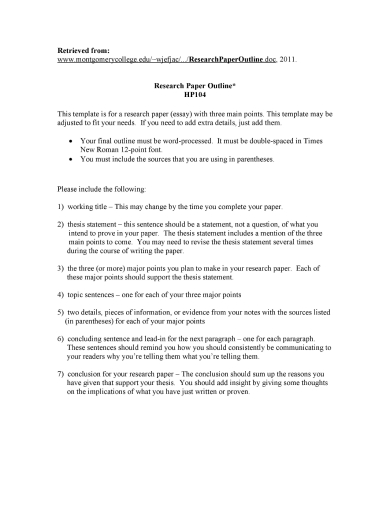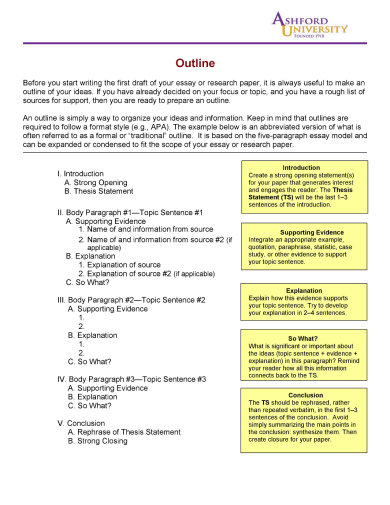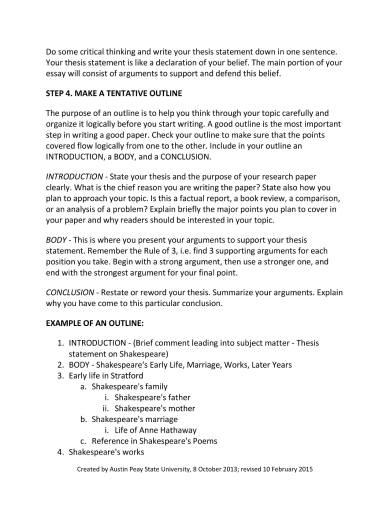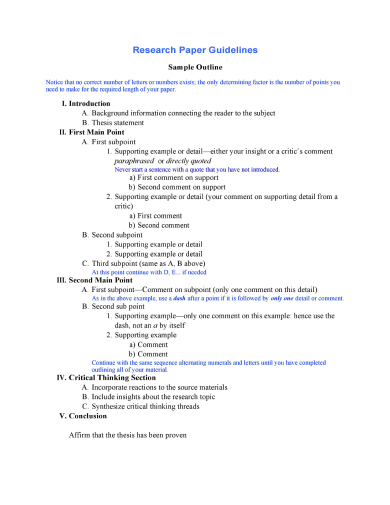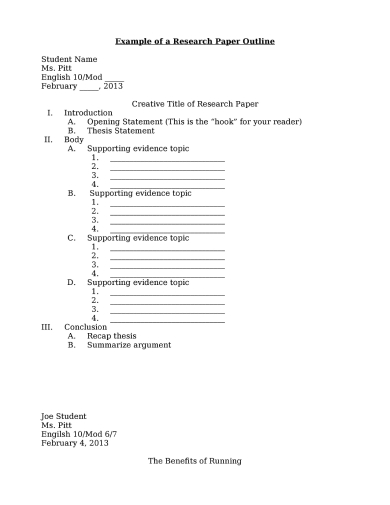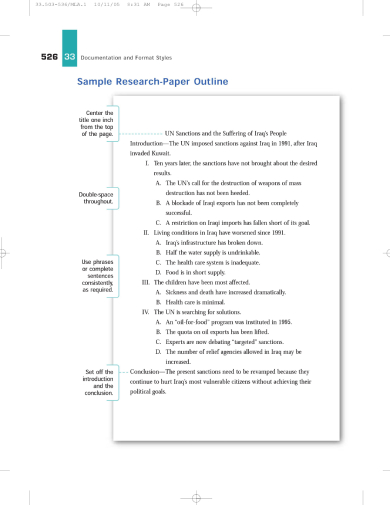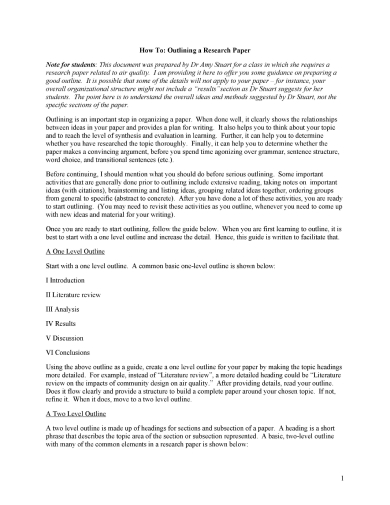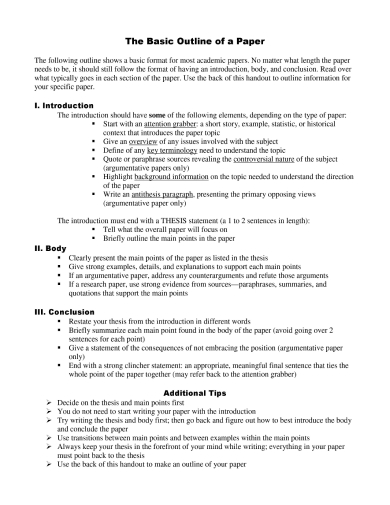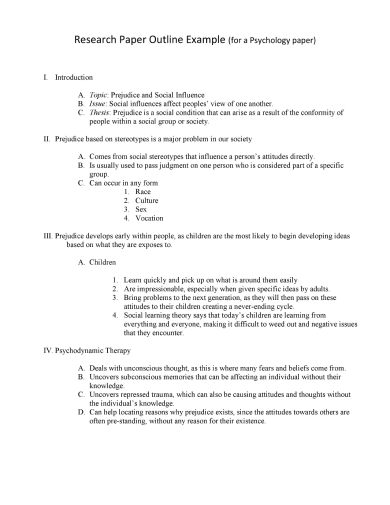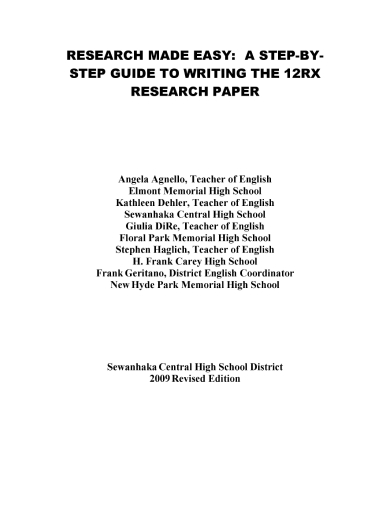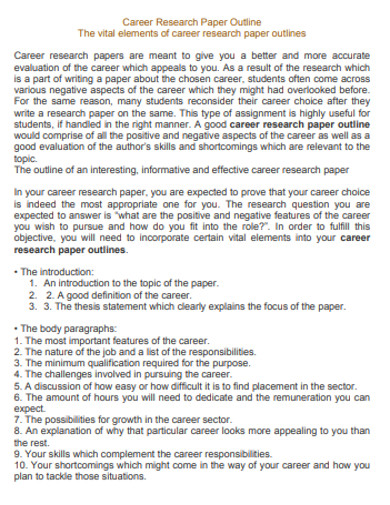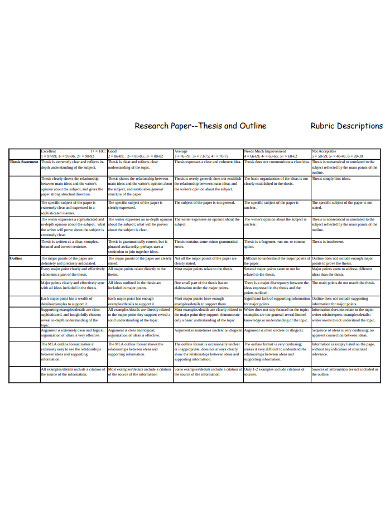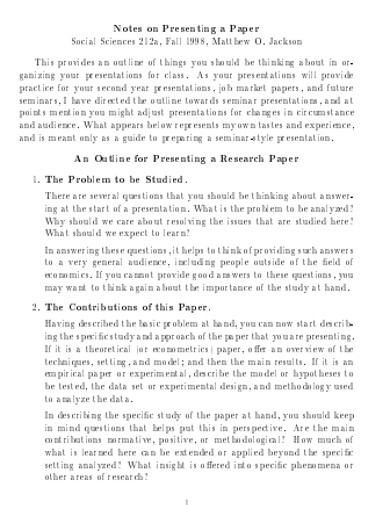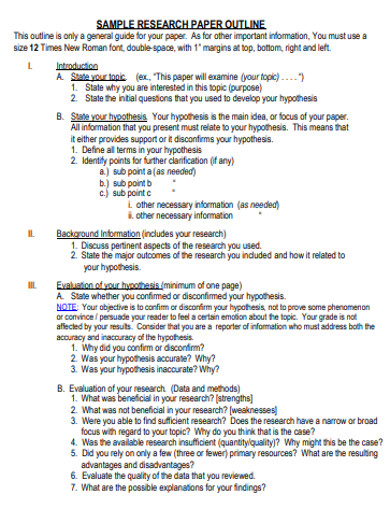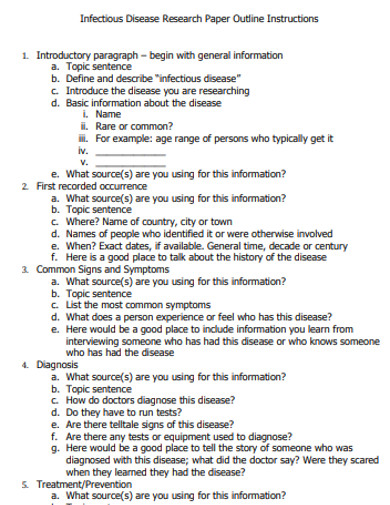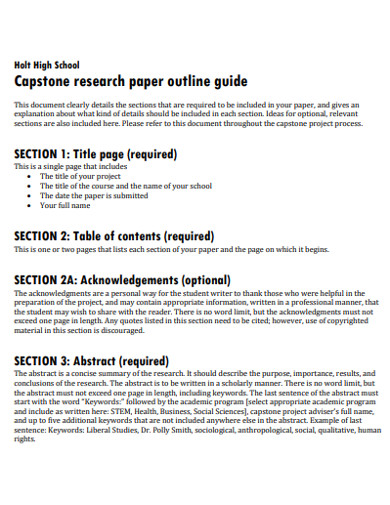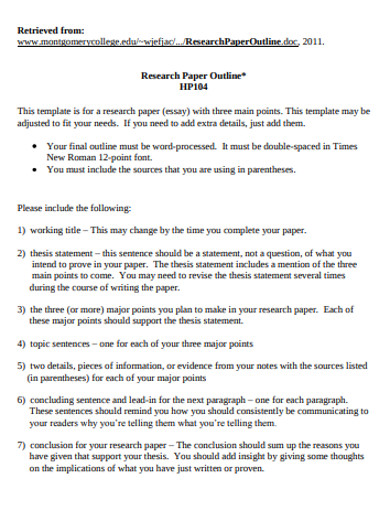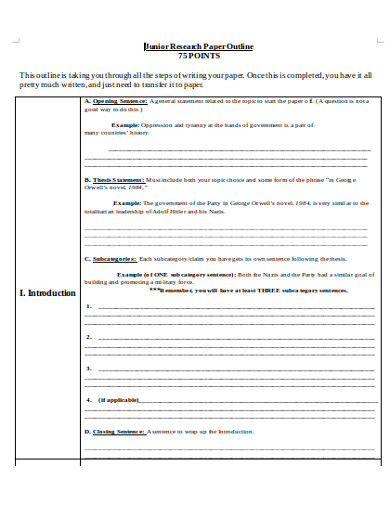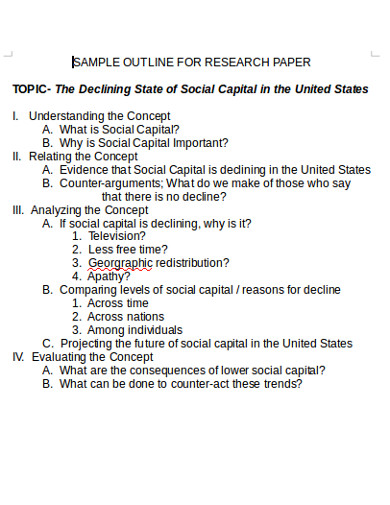19+ Research Paper Outline Examples
Apart from a report outline and a presentation outline, a research paper outline is one of the most common types of outlines you’re likely to encounter in any given field. This outline is incredibly useful in both business and education, as it serves as a guide for students and employees to further understand a certain topic. But before you begin creating the outline of your research paper, make sure you know how to structure it first. In this article, we shall discuss the basic elements of an outline with the help of a few examples.
Research outlines come with variety. To give you some visual representation of these tools, here are some examples of research paper outline in PDF file format you could rely on.
What is Research Paper?
Research Paper Format
Example of Research Paper
Basic Research Paper Outline
Educational Research Paper Outline
Simple Research Paper Outline
Comprehensible Research Paper Outline
Plain Research Paper Outline
What Is a Research Paper Outline
Outlines are tools that are used by authors to chronologically arrange their written ideas about a central topic or thesis. Details in an outline are deductively written which means that it starts by mentioning the major topics, followed by subtopics and supporting details. Outlines are utilized by writers to provide themselves a plan or blueprint on what to include in their papers. Moreover, outlines vary from very general to very specific as well as formal to informal.
Similarly, a research paper outline also does the same. It also functions as a guide for the researchers to identify what pieces of information do they need to involve in their research document.
Essential Parts of a Research Paper Outline

The outline structure of a research paper is fairly similar to that of a book outline. The only difference is the actual content presented in the paper. For us to further understand the significant components of a research paper outline, let us discuss each part accordingly:
Introduction
The introduction is considered to be the most important part of your outline, as it gives readers a general overview of what your topic is about. Here, your thesis statement along with the purpose of your study must be stated clearly. You also have the option to include your reason for studying such a topic and its significance. The methodology and the aims for the investigation must also be emphasized in your introduction. To put it simply, the introduction of your outline should stress out the major points addressed in the research paper.
Body
The body of your outline is where you will need to present every valid argument to support your topic or thesis statement. The best approach to follow would be the “Rule of 3”, in which you must find three supporting arguments to express your point. The body is also composed of several paragraphs or subparts, which include the background of the problem and other supporting data. You may also see a speech outline.
Conclusion
The final part of an outline paper is the conclusion. This consists of a summary of all the major points mentioned to arrive at your final stand on the issue or subject tackled. Be sure to expound your thoughts briefly and concisely in this section, as you don’t want to end up adding a different argument to the outline. Remember to mention the thesis statement again to connect each point accordingly. It’s also advisable to state recommendations or formulate the prospect for future studies in your conclusion. You may also see a chapter outline.
Listed below are examples of a research paper outline:
Sample 1
Topic: Asbestos Poisoning
I. Introduction
- Definition of the Topic
- Significance of the Study
- Definition of Terms
II. Body
- Symptoms of Asbestos Poisoning
- Effects of Asbestos Poisoning
- Possible Treatments
III. Conclusion
- Conclusion
- Recommendations
- How to Deal with Asbestos Hazards
Sample 2
Thesis: Abortion: Main Causes and Effects
Introductory Clause
- Brief introduction of the issue
- Definition of terms
- The theoretical basis for the paper
- Methodology
- Thesis statement
- Review of related literature
- Significance of the study
Main Body
a. Background of the problem
- The history of abortion and the primary causes that lead modern women to consider this method (possible causes such as religion, financial status, career issues, etc. must be expounded)
- Explain the position or stand of the church and the state regarding this problem
- General information about the possible consequences of abortion supported with valid facts, scientific articles and studies, examples, etc.
b. Available alternatives to abortion along with their pros and cons.
c. Advantages and disadvantages of abortion
- Explain all advantages of abortion, with supporting facts and examples
- Explain all disadvantages of abortion (both physical and mental), with supporting facts and examples
Final Clause/Conclusion
a. Conclusion
- A short analysis of all the facts provided in the paper
- Rephrased thesis statement
b. Recommendations for future studies
Based on the examples above, the structure of your outline must consist of a series of headings and subheadings of the said topic. Since an outline must only emphasize the primary points of your research, then you must keep it brief yet informative enough for readers to comprehend.
How to Create an Outline

A well-made outline is essential in locating significant information and keeping track of large amounts of data from a research paper. But an outline must be created properly for it to be understood by a reader, which is why the information should be organized in a logical or hierarchical order for everyone’s convenience. You may also see biography outline.
1. Begin with your thesis statement. It’s important to start your research paper outline with your thesis statement, or at least a topic sentence that supports your thesis statement. So when a person reads your outline, they can immediately identify what your research paper is all about.
2. List down the major points of your research paper. Create a list of strong arguments that must be highlighted in your outline. It would be best to organize them properly by sectioning them into particular categories. You may even label each part in Roman Numerals (I, II, III, IV) to make it easier for readers to find what they are looking for in your outline. You may also see tentative outlines.
3. Note down supporting ideas or argument for each point listed. For every major argument listed, there must be a series of supporting ideas to back up its claims. This usually consists of facts or examples that prove the credibility of such a claim. Similar to the central points of the paper, it is important to keep this section organized by labeling each idea in capital letters (A, B, C). You may also see a resume outline.
4. Subdivide each supporting topic. If necessary, you can continue to subdivide each point to fully expound the ideas presented. This will help make your outline even more informative for readers to grasp. You can then label them with numbers ( 1, 2, 3 ) and lowercase letters ( a, b, c ).

Creating an outline for your research paper isn’t as daunting as it may seem. It’s a step-by-step process that requires proper analysis and comprehension to carry out. If you’re having trouble writing your research paper outline, then it might be better to start off with a rough outline first. After which, you can then make the necessary adjustments to complete your final outline. By studying various outline samples, you’re sure to come up with the perfect research paper outline in no time.
MLA Research Paper Outline
Air Quality Research Paper Outline
Academic Research Paper Outline
Psychology Research Paper Outline
Students Research Paper Outline
Career Research Paper Outline
Research Paper Outline Example
Printable Research Paper Outline
Sample Research Paper Outline
Research Paper Outline Format
Research Paper Outline Guide
Research Paper Outline in PDF
Simple Research Paper Outline Example
Junior Research Paper Outline
Sample Research for Outline Paper
A Step-by-Step Guide to Research Process
The research process is the act of identifying, locating, assessing and analyzing of different pieces of information that are needed to support your research question. Then, the collected data will help you derive a rational conclusion. The research process is systematic and is important for you to build your own paper. To help you construct your own research process, you may follow these steps:
1. Distinguish and select a research topic.
Choosing your research topic could be a very critical step to take. It is not just because it is the first move but also due to the fact that your whole research process revolves around this topic; thus, it should be done correctly. To explain further, here are some points you need to remember:
Stick with the parameters. Whether you are making one for academic purposes in middle school or for your job, you need to be wary of the given criterion given by your instructor. Following these are really vital since it is the key to your next step. If you fail to obey the said parameter, it could disqualify or deem your paper proposal invalid. Most of the times, clear guidelines are given to help you take the first step; however, if there’s none, ask to clarify this issue.
Go for interesting topics. Needless to say, composing your own research paper would more enjoyable if the topic is what you truly want to explore. Furthermore, doing your research will be easier since you are having fun on the process.
Go for topics with numerous possible information sources. Assuming that there are numerous things that interest you then identify which of these has loads of various potential basis of information. To do this, you can conduct a preliminary searching of information in various sources such as books, journals, and the holy-grail internet. There’s no need on taking notes yet, simply ponder whether the available pieces of information are capable of meeting your needs and could support your study. If you find too many information, you may need to narrow your topic; if you find too few, you may need to widen your topic.
Never forget to be original. The most probable reason for you to write your own research paper is for your academic completion. Hence, the most possible recipient of your work will be your instructor. Now, consider that your instructor already read thousands of research paper and the only way to stand out is to be rationally different. Think outside the mundane way of thinking, be creative and be innovative. In other words, be original.
Never hesitate to ask for help. Though it may sound absurd, consulting your instructor about this issue would be a great help. Thinking that in most cases, your instructor would be one of the people that would give verdict on your paper, conducting research on ideas that came straight from him/her would be a great advantage.
If you already have a topic with you, it would also be helpful to turn it into a specific question. Doing this would surely make your research concepts and keywords identification a lot easier. For instance, if you are really into music then you can simply pinpoint a specific topic related to that such as:
- What are the effects of pop music to the performance level of students?
- What makes us have different musical tastes?
- What makes a piece of music good to hear?
2. Search for in-depth information.
Now that you have a specific central topic to talk about, it is time to look for deeper information. Utilize the best form of source or material that is appropriate for your study. For example, if you are in search of objective information, you can use books, magazines, journals, and internet. However, there are some details that need a different approach such as responses. In these cases, conduct a survey, observation or interview instead. Moreover, take note of your sources in doing this step.
3. Examine your sources.
In research, there are certain criteria to consider your information valid and reliable. Check on your sources’ date of publication of the information you have gathered. The common acceptable range is 5 years from the present. If you are using the internet as your source, check on the top-level domain if it is either “.edu,” “.gov,” “.org,” etc.
4. Take note.
Making a note of the different data and sources are very important in your research process. This will serve as your guide on which of those are useful for your paper. Moreover, don’t forget to include the author, title, publisher, URL and other details that will be used in citing them.
5. Begin writing your paper.
You may start by constructing a research paper outline which we discussed earlier and follow it by writing a rough draft. Remember, there is no need to be perfect right away. The main purpose of making a rough draft is to organize your information and help you in forming your final paper. Afterward, review and edit your draft as many times as necessary.
6. Cite your sources.
It is important to recall that not all information in your research paper is not yours; thus, it is just appropriate to cite them in your bibliography or reference list. By doing this, you are able to give a polite credit to the authors of the different information you have used and also to avoid plagiarism. Moreover, these would allow your reader to locate the sources of your information for verification and duplication purposes. Remember, there are different styles and formats in citing your sources. MLA, APA, and Chicago are some of the most used citation formats.
7. Proofread your work
The last step before publishing your work is to proofread your work. Simply read over your research paper and see whether there are any grammatical, spelling or any other unnoticed technical and textual errors. Proofreading is also important to check if your paper is speaking of what you really want to imply and inspect if you are following the proper citing process. Before doing this step, it is recommendable to take a break or consult the help of a proficient friend.



